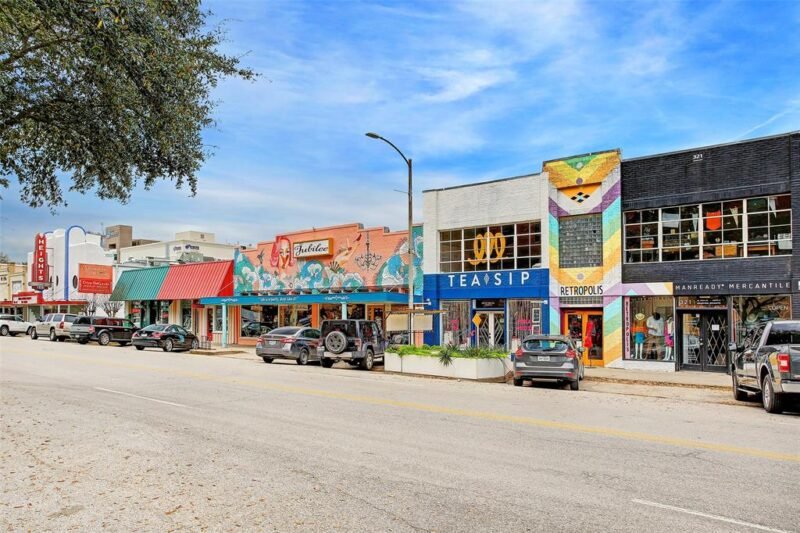Midtown is a central Houston neighborhood located west-southwest of Downtown. Midtown is defined by a continuation of Downtown’s square grid street plan, anchored by Main Street and the METRO Rail Red Line, and is separated from Downtown by an elevated section of Interstate 45 (the Pierce Elevated). Midtown is bounded to the west by Neartown (Montrose), to the south by the Museum District, and to the east by Interstate 69. Midtown’s 325 blocks cover 1.24 square miles (3.2 km2) and had a population of nearly 8,600 people in 2015.
Midtown was originally populated as a Victorian-style residential neighborhood in the nineteenth century but experienced an economic depression in the latter half of the twentieth century, resulting in the departure of residents and businesses and the proliferation of vacant land. The creation of the Midtown Redevelopment Authority in the early 1990s, combined with a renewed interest in Houston’s urban core, resulted in the district’s gentrification throughout the 2000s, fueled by an influx of young residents and the development of a vibrant nightlife. Midtown’s street signs, like many other gentrified areas of Houston, are themed, specific to the area’s logo, and there are many parks, sculptures, and businesses that include “Midtown” in their name, as a form of economic unity and to attract more visitors and residents. Midtown’s rapid development has continued into the 2010s, but the district still faces issues such as crime, inadequate infrastructure, chronic homelessness, and geographic disparities in public investment.
What is now Midtown was divided into the Third and Fourth Wards around 1906. Prior to the 1950s, what is now Midtown was a popular residential neighborhood. Homeowners are increasingly leaving for less congested areas as a result of commercial development. The neighborhood evolved into a collection of small apartment complexes, low-rise commercial buildings, and older homes. According to a City of Houston report, the neighborhood’s “only stability” was provided by the remaining churches and the Houston Community College System Central campuses.
Little Saigon, a neighborhood of Vietnamese and Vietnamese Americans, pioneered the redevelopment of Midtown Houston in the 1970s. Travis and Milam Streets were viewed as a mirror image of 1970s Saigon in the 1980s. Milam Street, Webster Street, Fannin Street, and San Jacinto Street were designated as Vietnamese areas. By 1991, Little Saigon was home to Vietnamese restaurants, hair salons, car dealerships, and travel agencies. According to Mimi Swartz of Texas Monthly, “Little Saigon is a place to begin easing into a new country.”
Isabella Court, located at 3909-3917 South Main Street, was added to the National Register of Historic Places on June 24, 1994.
The Midtown Tax Increment Reinvestment Zone (TIRZ) was established by the City of Houston in 1995. The creation of the TIRZ prompted the construction of upper-income townhomes and apartment complexes in western Midtown and along Elizabeth Baldwin Park. Between 1990 and 2000, the population of the Midtown Superneighborhood increased from 3,070 to 5,311. The increase of 2,241 people represented 73 percent of the population in 1990. Approximately 2,200 multi-family units were built during that time, primarily along Louisiana Street and West Gray Street. Because the total multi-family acreage remained small, the population growth increased the area’s density. Commercial uses increased in the 1990s, particularly along Main Street and Louisiana Street. The Midtown Management District was established by the 76th Texas Legislature in 1999.
Higher rents and street construction had reduced the number of Vietnamese American businesses by 2004, with many of them relocating to the outer Houston Chinatown in the Bellaire Boulevard corridor west of Sharpstown. During the 6th Annual Asian Pacific American Heritage Month Festival on May 1, that year, the section of Midtown along Milam Street and Travis Street near Tuam Street was dubbed “Little Saigon.”
The Midtown TIRZ was expanded by 8 acres by the Houston City Council in 2009. The Asia House, the Buffalo Soldiers Museum, and the Museum of African American Culture are all part of the new territory.
Midtown was named the favorite neighborhood for millennials by the ranking website Niche in 2014.
https://goo.gl/maps/ppiAhTXj4fCozqXE9
<iframe src=”https://www.google.com/maps/embed?pb=!1m18!1m12!1m3!1d27713.976882873812!2d-95.39272066000679!3d29.74156074756794!2m3!1f0!2f0!3f0!3m2!1i1024!2i768!4f13.1!3m3!1m2!1s0x8640bf6c893e9205%3A0xea1d6aa2ed32750b!2sMidtown%2C%20Houston%2C%20TX%2C%20USA!5e0!3m2!1sen!2sin!4v1623883684376!5m2!1sen!2sin” width=”600″ height=”450″ style=”border:0;” allowfullscreen=”” loading=”lazy”></iframe>


No Comments
Be the first to start a conversation